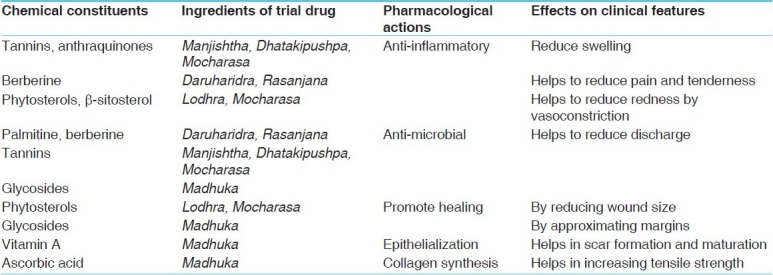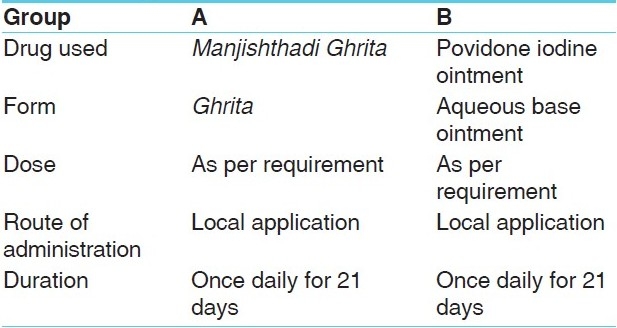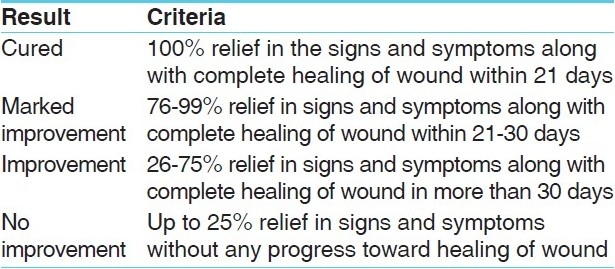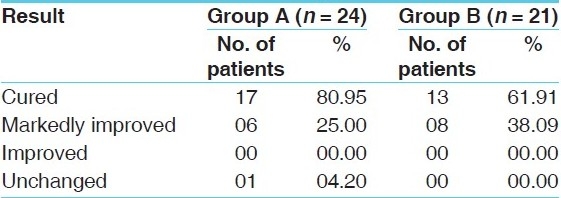Abstract
Healing of vrana (wound) is either primary or secondary by nature. Secondary healing requires more attention than primary healing. Basically, two things, shodhana (making free from undesirable healing factors) and ropana (closure of wound), are desirable for proper healing. Many drugs have been described in classics for healing, but none of them is capable of healing the wound individually. Hence, to fulfill the aim, manjishthadi ghrita was prepared with the help of 7 drugs having vrana ropana effects and was evaluated clinically for its healing properties in this study. It was used topically in postoperative wounds, mostly of ano-rectal cases, twice a day, for 21 days. The follow-up period was 1 month to observe the healing as well as vaikritapaham (reduced deformity) properties and any untoward effects of the drug. A randomized control clinical trial was done. Out of 45 patients, 24 patients in group A were treated with “Manjishthadi Ghrita” (treated group), while 21 patients in group B (standard group) treated with povidine iodine ointment. Better result was observed in the treated group in comparison to the standard group. No adverse effect was observed in any patient. Manjishthadi ghrita can be prescribed as a local healing agent for common wound.
Keywords: Manjishthadi ghrita, ropana, shodhana, vaikritapaham, vrana, wound healing
Introduction
Ayurveda is an applied science and time-tested health system with vast scope of trials to prove certain principles as well as therapeutic effects of the medicines, which is the need of the hour to make the Ayurveda more acceptable globally. Classics of Ayurveda have emphasized at various places to take care of wounds which occur due to vitiated doshas or any trauma. Sushruta, an eminent surgeon of his era, was much ahead of his time in expounding and practicing the beautiful concept of vrana ropana (wound healing). The Shalya chikitsa brings out very clearly that vrana (wound) is the most significant surgical entity and the knowledge of its effective management for a surgeon is the basic skill required on which the outcome of surgery revolves. There is a constant need to deal with the inflammation as well as problems in healing in different surgical disorders. The process of wound healing is almost same at the terminal stages, whereas at initial stages it shows some differences and includes a number of cellular and molecular phases till the process of healing is completed.[1] Since time immemorial, it has been an ongoing process to search out better remedy in order to overcome the previous drawbacks.
Exposure to infection and prolongation of inflammatory phase plays the prime role to delay the healing process, whereas creating the favorable conditions that allow the wound to heal properly is the ultimate aim of any surgeon. There are many measures to create favorable conditions for wound healing, such as use of antiseptic solutions and antibiotics to combat the infection, inflammation and many agents to remove slough/dead tissues to shorten the inflammatory phase and thus promote the healing process.
But these measures have failed to achieve good cosmetic effect by not producing minimal and fine scar formation. This is why the search is still on to find out a drug or drug combination which can fulfill the optimal requirement. The healing activities have been attributed partially by very few active chemical constituents like berberine in Daruharidra (Berberis aristata DC), anthraquinones found in Manjishtha (Rubia cordifolia Linn.), etc. and studies reveal that it is difficult to achieve the complete aim of wound management with a single drug. Hence, there is a need to find out a rational and optimal healing compound for the wound management in a better way. Here, it is important to find out a single and effective formulation which possesses both vrana shodhana and vrana ropana properties. Many studies have been carried out regarding vrana ropana some of the studies are mentioned here: e.g., (i) Clinical and experimental study of karpoora ghrita in vrana ropana, Dr. Harshit Shah, 2002, I.P.G.T. and R.A., Gujarat Ayurved University, Jamnagar, Gujarat; (ii) Comparative study of durvadi taila and povidone iodine in the management of dushta vrana, Dr. Lalit Pankhaniya, 2008, I.P.G.T. and R.A.; (iii) Clinical and experimental study of Yashtimadhvadi compound in vrana ropana, Dr. Rakhee Gupta, 1995, I.P.G.T. and R.A.; and (iv) Role of Snuhiksheer and Apamarga kshara in the management of dushtavrana, Dr. Jahagirdar Parag Vilas, Banaras Hindu University, 2003. But none has focused on the vaikritapaham properties of the drugs. In the present study, in addition to vrana shodhana and vrana ropana effects, vaikritapaham (free from any marked deformity), which is also the prime need of today's cosmetic era, has been considered. The ropana action is one of the most important actions amongst the vranasya shashti upakramas of Sushruta. Though the herbal drugs are prescribed with high appreciation for healing purpose, they need scientific validation with proper study design. Keeping all these factors in view, a group of certain effective drugs has been selected after reviewing the literature and a compound formulation of 7 efficient drugs named “Manjishthadi Ghrita” has been prepared in which Manjishtha (R. cordifolia Linn.), Daruharidra (B. aristata DC), Mocharasa (Salmalia malabarica), Dhatakipushpa [Woodfordia fruticosa (Linn.) Kurz.], madhuka (Madhuca indica J.F. Gmel), Lodhra (Symplocos racemosa Roxb.) and Rasanjana (Extractum berberis) have been included. Hence, the above compound formulation “Manjishthadi Ghrita” having vrana ropana (wound healing) property has been selected for clinical evaluation.
Aims and objectives
To assess the clinical efficacy of the Manjishthadi ghrita (trial drug) for wound healing.
Materials and Methods
The work was carried out after obtaining approval from the Institutional Ethical committee, Institute for Post Graduate Teaching and Research in Ayurveda, Jamnagar.
Drug contents
An innovative compound Manjishthadi ghrita of 7 reputed drugs having healing properties, described in the Sushruta samhita, was prepared with ghrita kalpana in the pharmacy of Gujarat Ayurved University, Jamnagar, Gujarat.
Among the three ganas (Priyangvadi, Ambashthadi and Nyagrodhadi gana),[2] the following seven drugs were selected for this study:

Drug preparation
After identification of the raw drugs at the Pharmacognosy laboratory, I.P.G.T. and R.A., trial drug “manjishthadi ghrita” was prepared as per the classical reference of ghrita paka kalpana[3] and finally physico-chemical analysis of the prepared drug was done in the pharmaceutical chemistry laboratory of I.P.G.T. and R.A. This Manjishthadi Ghrita in the form of ointment was made tube packed for easy application [Tables 1 and 2].
Table 1.
Pharmacodynamic properties of Manjishthadi Ghrita

Table 2.
Chemical constituents of the trial drug, Manjishthadi Ghrita

Clinical Study
Sample and data source
A total of 45 patients attending the OPD/IPD of dept. of Shalya Tantra, I.P.G.T.R.A., Jamnagar were studied, with 24 patients in group-A (manjishthadi group) and 21 patients in group-B (povidone iodine group).
Criteria of selection
Patients were selected with Shuddha vrana formed after cut-through of ligated kshara sutra in different cases like piles and fissure, excised cyst, excised pilonidal sinus, excised corn, etc.
Criteria of exclusion
Patients with systemic diseases like diabetes, tuberculosis and chronic non-healing ulcers were excluded from this study.
Methods
The application of Manjishthadi ghrita in group A and povidone iodine ointment in group B patients was done as per the detail mentioned in Table 3.
Table 3.
Drug administration and dose schedule

Criteria for assessment
The subjective parameters of pain, tenderness and objective parameters of size, color, floor, margin, discharge, granulation tissue and swelling were recorded on the basis of the score adopted with grading (0, 1, 2 and 3). After completion of treatment, assessment of scar was done on the basis of gradation (0, 1, 2 and 3).
Criteria for assessment of total effect of therapy are given in Table 4.
Table 4.
Criteria for assessment of total effect of therapy

Observations and Results
Among the 45 patients studied, male patients were more in number (82.22%) than females and majority of them were found in the age group of 21-30 years (35.55%). The 42.22% of the patients were found to be addicted to tobacco chewing and 20.00% patients were addicted to smoking. Irregular shape of the wound was observed in maximum (51.10%) cases. Single vrana was observed in majority of the patients (88.90%). Maximum cases studied were having the wound in anal region (80.00%). Wound size measured 3 × 2 cm in maximum number of patients (40.00%), showing sloping edge (95.83%), non-edematous margin and bed covered with reddish and healthy granulation tissue (95.83%) having mild discharge (4.17%). Majority of the patients had wounds of postoperative cases of piles (44.40%) and fissure wounds (37.80%). In all the patients, the type of wounds was “agantuja” in origin. The chief complaints were pain and tenderness, found in 66.70% of the patients. No patient had complained of swelling and only 02.22% patients had complained of discharge from the wound.
Effect of therapy on scar formation
Scar size was observed to be minimal in group A (82.60%) in comparison to group B (66.67%). Scar color was near to the skin color in 60.90% patients in group A and 58.10% patients in group B. The 86.90% showed normal, smooth, even and regular formation of scar in group A, and 81.00% of patients showed the same in group B. Consistency of scar was found to be normal in 65.20% patients in group A and 66.60% patients in group B, whereas condition of scar was normal (neither elevated nor depressed) in 70.00% of patients in group A and 68.00% of patients in group B.
Discussion
Wound healing is completed in three phases: Inflammatory, proliferative and remodeling. Granulation, collagen maturation and scar formation are some of the other phases of wound healing which run concurrently but are independent of each other.[4] Ropana is always associated with shodhana because a wound cannot be healed if it is not shuddha.
Hence, the drugs, Manjishtha, Daruharidra, Mocharasa, Dhatakipushpa, Madhuka, Lodhra and Rasanjana, having both the properties, i.e., shodhana and ropana, had been selected for this study. After studying their properties, an innovative compound drug had been prepared and named “Manjishthadi Ghrita” on the basis of Manjishtha, used as a prime healing drug described in ayurvedic literatures. An attempt was made to explore the shodhana and ropana properties of the trial drug scientifically. Vrana ropana involves shodhana followed by ropana; two stages happen practically, i.e., subsiding local shotha by removal of local dhatu dushti, followed by initiation of ropana process, i.e., contraction and covering of wound by epithelial layers.
Removal of local dhatu dushti
The grading of shuddha wound depends on the amount of dushti present in local dhatu, i.e., twaka and mamsa with rakta dhatu. The trial drugs contained lekhana (scraping), shoshana (absorptive) sthambhana (coagulation/contraction) and rakta shodhaka (blood purifier) properties, along with samshodhana (detoxifying, cleansing) which provided the desired effect. The ropana of vrana (wound) could have been possible after shodhana (medical debridement) due to removal of dhatu dushti with the help of Yogavahi (catalytic) properties of go-ghrita. Yogavahi (catalytic) properties of go-ghrita which removed and clean dhatu dushti as well as carried out the shodhana (medical debridement) at the site of vrana would have been acted and promoted the ropana of vrana (wound).
Effect on the clinical features
Ropana (healing) of any vrana (wound) cannot occur without the reduction of the clinical features of shotha (inflammation). Though it is necessary for ropana (healing) of vrana at early stages, it delays the healing if persists for a longer duration. As stated earlier, the rasa, guna(s) and karma(s) of the trial drug helped to check the clinical features of the vrana.
Prinana (nutrition), dhatuvardhana (tissue growth) poshana (nourishment)-all activities must be performed by madhura rasa and it helps to contract the wound size by promoting fibrosis and epithelialization. Vatahara due to snigdha and guru guna, shothahara and dahashamana (anti-inflammatory) effects was observed due to sheeta guna and kashaya rasa which helped to reduce the inflammation and thus relieved the pain and tenderness. Rakta shodhana (purification of blood) was done by virtue of tikta and kashaya rasa. Pittashamana, varnya (coloration) and twaka prasadana (to make skin healthy) actions aided to improve the skin color by improving the local blood circulation. Stambhana karma was done by shoshana guna of kashaya, tikta rasa and vishada guna along with kledahara, raktasthambhana and chhedana activities, followed by krimighna karma (antimicrobial action) which led to prevention of discharge and secretions. Lekhana, kledahara, chhedana and raktashodhaka properties of vishada guna of kashaya rasa played important role in scraping out the debris and slough of the vrana. Infection was checked by the krimighna and vishaghna properties of the go-ghrita of the compound drug. Ultimately, normal scar tissue was observed with minimal size, near to normal skin color, smooth, even and regular surface with normal consistency. Balya and poshana karma of madhura rasa helped in promotion of healing by dhatuvardhana (growth of the tissue) leading to healthy and desired scar formation. Varnya, twaka prasadana, raktaprasadana properties of the madhura rasa with snigdha guna led to coloration of scar tissue similar to that of skin. Snigdha and balya properties of madhura rasa of the individual drugs as well as go-ghrita produced normal, even and smooth scar. Qualities of kashaya rasa,[5] snigdha and laghu guna of the drug led to even and regular consistency of scar formation without any complications. Phytosterols, the chief components of ghrita, are known to be good emulsifiers, the property of which was assumed to facilitate the penetration of drug into the tissue. Tannins and anthraquinones are known antioxidants and blood purifiers with anti-inflammatory actions. As the oxidation process hampers the wound healing, antioxidants protect the tissue from the oxidative damage. Tannins also reduce the secretions, whereas palmitine and berberines both have bactericidal action and glycosides have anti-infective activity which combated the infection and thus prevented infections in the wound. Tannins, anthraquinones, berberine, and phytosterols – all are anti-inflammatory and thus prevented the prolongation of the initial phase and reduced the pain as well as tenderness, redness, swelling like features, which led to progress of the wound toward healing. Tannins and phytosterols promoted the healing process by wound contraction with increased capillary formation and fibroblast proliferation, followed by enhanced rate of epithelialization. Glycosides accelerated the healing process and reduced the scarring, as the proposed mechanism of action involves the regeneration of skin through stimulation of stem cells that allowed healing without substantial scar formation. Ascorbic acid is an important requirement for collagen connective tissue synthesis which leads to wound contraction and scar maturation by cross-linking of collagen fibers. Vitamin “A” is essential for epithelialization which lessens the pigmentation and improves the condition of the scar. Fecal contamination of an anal wound gives rise to major local or systemic sepsis,[6] and as majority of the cases were of postoperative ano-rectal wounds, it can be assumed that the drug was able to prevent any such conditions of infection and thus helped in the healing process.
The statistical data revealed that highly significant results were obtained in size, floor, color, and margin as well as in features of the pain. Significant results were obtained in discharge and unhealthy granulation tissue formation in the wound in all the cases of both the groups, except one case in group A, which was due to irregular reception of the treatment [Tables 5 and 6].
Table 5.
Effect of therapy on different signs and symptoms in patients of group-A (Manjisthadi Ghrita group)

Table 6.
Effect of therapy on different signs and symptoms in patients of group-B (Povidone Iodine group)

Average number of days required for wound healing was lesser in group A as compared to group B. This indicates that the Manjishthadi Ghrita was effective in clean and healthy ano-rectal and other wounds as a healing compound [Table 7]. All the treated wounds showed secondary healing within a range of 21-25 days, with a lighter, minimal and smooth scar formation without any complications in group A, whereas group B patients showed little larger, darker and firmer scar formation.
Table 7.
Overall effect of therapy

Conclusion
To conclude, we can say that on treatment with Manjishthadi Ghrita, the process of repair was not complicated by infection with micro-organisms. So, there was no interference with the general health of the patient. The temperature remained normal; the circulatory, gastrointestinal, nervous systems, and other functions were undisturbed; locally, the part was cool, of natural color and free from pain.[7] It can be concluded that the wounds healed within 21 days with good results in the form of normal colored scar formation without any complication in the trial group, which proved the vaikritapaham property of the compound drug. Local application of Manjishthadi ghrita provided good result by reduction of the wound size and promotion of healing, and it proved to be cosmetically effective with least scar formation also. Pigmentation similar to that of skin was found as another updating effect which was not seen in povidone iodine group. No untoward effects were observed during the course of treatment.
Hence, from this clinical study, it can be concluded that the drug Manjishthadi Ghrita possesses high efficacy in “vrana ropana” with fine scaring without producing any adverse effect. So, it can be recommended as a cost-effective, easy to prepare and effective therapy for wound healing.
References
- 1.Clark RA. Cutaneous wound repairs. In: Goldsmith LA, editor. Physiology, Biochemistry and Molecular Biology of Skin. New York: Oxford University Press; 1991. p. 576. [Google Scholar]
- 2.Shastry Ambikadutta., editor. sutrasthana. Reprint edition. 45-48. Vol. 38. Varanasi: Chaukhambha sanskrit sansthana; 2007. Sushruta, Sushruta samhita with ayurvedtatvasandipika ommentaries; pp. 144–5. [Google Scholar]
- 3.madhyam khanda, chapter-9. Varanasi: Chaukhambha sanskrit surabharati prakashana; 2008. Sharangdhara, Sharangdhara Samhita; p. 218. Commentator- Dr Brahmananda Tripathi. [Google Scholar]
- 4.Townsend CM, Beauchamp DR, Evers MB, Mattox KL. 17th ed. Amsterdam: Elseviers Saunders; 2004. Sabiston's Textbook of Surgery; pp. 1–15. [Google Scholar]
- 5.Bhavamishra . Bhavaprakash Nighantu. In: Pandey GS, Mishra Prakarana, editors. Varanasi: Chaukhambha Bharati Academy; 2004. p. 187. commentary by Chunekar KC. [Google Scholar]
- 6.Margaret Farquharson and Brendan Moran Chp 23. 9th ed. London: Hodder Arnold; 2005. Farquarson's Textbook of Operative General Surgery; p. 439. [Google Scholar]
- 7.6th ed. Vol. 1. Oxford: Oxford Medical Publications; 1990. Manual of Surgery, Alexis Thompson and Alexander Miles, Chapter 1; p. 14. [Google Scholar]


